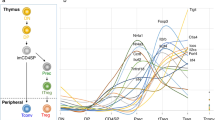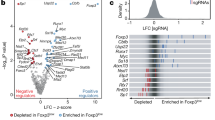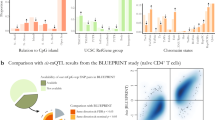Abstract
Systemic lupus erythematosus (SLE) is an autoimmune disease characterized by the production of autoantibodies against a host of nuclear antigens. The pathogenesis of lupus is incompletely understood. Environmental factors may play a role via altering DNA methylation, a mechanism regulating gene expression. In lupus, genes including CD11a and CD70 are overexpressed in T cells as a result of promoter hypomethylation. T-cell DNA methyltransferase expression is regulated in part by the extracellular signal-regulated kinase (ERK) signaling pathway. In this study, we investigate the effects of decreased ERK pathway signaling in T cells using transgenic animals. We generated a transgenic mouse that inducibly expresses a dominant-negative MEK in T cells in the presence of doxycycline. We show that decreased ERK pathway signaling in T cells results in decreased expression of DNA methyltransferase 1 and overexpression of the methylation-sensitive genes CD11a and CD70, similar to T cells in human lupus. Our transgenic animal model also develops anti-dsDNA antibodies. Interestingly, microarray expression assays revealed overexpression of several interferon-regulated genes in the spleen similar to peripheral blood cells of lupus patients. This model supports the contention that ERK pathway signaling defects in T cells contribute to the development of autoimmunity.
This is a preview of subscription content, access via your institution
Access options
Subscribe to this journal
Receive 6 digital issues and online access to articles
$119.00 per year
only $19.83 per issue
Buy this article
- Purchase on Springer Link
- Instant access to full article PDF
Prices may be subject to local taxes which are calculated during checkout








Similar content being viewed by others
References
Sestak AL, Nath SK, Sawalha AH, Harley JB . Current status of lupus genetics. Arthritis Res Ther 2007; 9: 210.
Sarzi-Puttini P, Atzeni F, Iaccarino L, Doria A . Environment and systemic lupus erythematosus: an overview. Autoimmunity 2005; 38: 465–472.
James JA, Kaufman KM, Farris AD, Taylor-Albert E, Lehman TJ, Harley JB . An increased prevalence of Epstein-Barr virus infection in young patients suggests a possible etiology for systemic lupus erythematosus. J Clin Invest 1997; 100: 3019–3026.
Sawalha AH, Richardson BC . DNA methylation in the pathogenesis of systemic lupus erythematosus. Curr Pharmacogen 2005; 3: 73–78.
Richardson B, Yung R . Role of DNA methylation in the regulation of cell function. J Lab Clin Med 1999; 134: 333–340.
Okano M, Bell DW, Haber DA, Li E . DNA methyltransferases Dnmt3a and Dnmt3b are essential for de novo methylation and mammalian development. Cell 1999; 99: 247–257.
Bird AP . Use of restriction enzymes to study eukaryotic DNA methylation: II. The symmetry of methylated sites supports semi-conservative copying of the methylation pattern. J Mol Biol 1978; 118: 49–60.
Deng C, Yang J, Scott J, Hanash S, Richardson BC . Role of the ras-MAPK signaling pathway in the DNA methyltransferase response to DNA hypomethylation. Biol Chem 1998; 379: 1113–1120.
MacLeod AR, Rouleau J, Szyf M . Regulation of DNA methylation by the Ras signaling pathway. J Biol Chem 1995; 270: 11327–11337.
Lu R, Wang X, Chen ZF, Sun DF, Tian XQ, Fang JY . Inhibition of the extracellular signal-regulated kinase/mitogen-activated protein kinase pathway decreases DNA methylation in colon cancer cells. J Biol Chem 2007; 282: 12249–12259.
Richardson B . Effect of an inhibitor of DNA methylation on T cells. II. 5-Azacytidine induces self-reactivity in antigen-specific T4+ cells. Hum Immunol 1986; 17: 456–470.
Richardson B, Powers D, Hooper F, Yung RL, O'Rourke K . Lymphocyte function-associated antigen 1 overexpression and T cell autoreactivity. Arthritis Rheum 1994; 37: 1363–1372.
Lu Q, Ray D, Gutsch D, Richardson B . Effect of DNA methylation and chromatin structure on ITGAL expression. Blood 2002; 99: 4503–4508.
Yung R, Powers D, Johnson K, Amento E, Carr D, Laing T et al. Mechanisms of drug-induced lupus. II. T cells overexpressing lymphocyte function-associated antigen 1 become autoreactive and cause a lupus like disease in syngeneic mice. J Clin Invest 1996; 97: 2866–2871.
Richardson BC, Strahler JR, Pivirotto TS, Quddus J, Bayliss GE, Gross LA et al. Phenotypic and functional similarities between 5-azacytidine-treated T cells and a T cell subset in patients with active systemic lupus erythematosus. Arthritis Rheum 1992; 35: 647–662.
Yung R, Kaplan MJ, Ray D, Schneider K, Mo R-R, Johnson K et al. Autoreactive murine Th1 and Th2 cells kill syngeneic macrophages and induce autoantibodies. Lupus 2001; 10: 539–546.
Kaplan MJ, Lu Q, Wu A, Attwood J, Richardson B . Demethylation of promoter regulatory elements contributes to perforin overexpression in CD4+ lupus T cells. J Immunol 2004; 172: 3652–3661.
Oelke K, Lu Q, Richardson D, Wu A, Deng C, Hanash S et al. Overexpression of CD70 and overstimulation of IgG synthesis by lupus T cells and T cells treated with DNA methylation inhibitors. Arthritis Rheum 2004; 50: 1850–1860.
Lu Q, Wu A, Tesmer L, Ray D, Yousif N, Richardson B . Demethylation of CD40LG on the inactive X in T cells from women with lupus. J Immunol 2007; 179: 6352–6358.
Cornacchia E, Golbus J, Maybaum J, Strahler J, Hanash S, Richardson B . Hydralazine and procainamide inhibit T cell DNA methylation and induce autoreactivity. J Immunol 1988; 140: 2197–2200.
Scheinbart LS, Johnson MA, Gross LA, Edelstein SR, Richardson BC . Procainamide inhibits DNA methyltransferase in a human T cell line. J Rheumatol 1991; 18: 530–534.
Lee BH, Yegnasubramanian S, Lin X, Nelson WG . Procainamide is a specific inhibitor of DNA methyltransferase 1. J Biol Chem 2005; 280: 40749–40756.
Deng C, Lu Q, Zhang Z, Rao T, Attwood J, Yung R et al. Hydralazine may induce autoimmunity by inhibiting extracellular signal-regulated kinase pathway signaling. Arthritis Rheum 2003; 48: 746–756.
Yung RL, Quddus J, Chrisp CE, Johnson KJ, Richardson BC . Mechanism of drug-induced lupus. I. Cloned Th2 cells modified with DNA methylation inhibitors in vitro cause autoimmunity in vivo. J Immunol 1995; 154: 3025–3035.
Quddus J, Johnson KJ, Gavalchin J, Amento EP, Chrisp CE, Yung RL et al. Treating activated CD4+ T cells with either of two distinct DNA methyltransferase inhibitors, 5-azacytidine or procainamide, is sufficient to cause a lupus-like disease in syngeneic mice. J Clin Invest 1993; 92: 38–53.
Mansilla-Tinoco R, Harland SJ, Ryan PJ, Bernstein RM, Dollery CT, Hughes GR et al. Hydralazine, antinuclear antibodies, and the lupus syndrome. Br Med J (Clin Res Ed) 1982; 284: 936–939.
Lu Q, Kaplan M, Ray D, Ray D, Zacharek S, Gutsch D et al. Demethylation of ITGAL (CD11a) regulatory sequences in systemic lupus erythematosus. Arthritis Rheum 2002; 46: 1282–1291.
Lu Q, Wu A, Richardson BC . Demethylation of the same promoter sequence increases CD70 expression in lupus T cells and T cells treated with lupus-inducing drugs. J Immunol 2005; 174: 6212–6219.
Deng C, Kaplan MJ, Yang J, Ray D, Zhang Z, McCune WJ et al. Decreased Ras-mitogen-activated protein kinase signaling may cause DNA hypomethylation in T lymphocytes from lupus patients. Arthritis Rheum 2001; 44: 397–407.
Syu LJ, Guan KL, Saltiel AR . Inducible expression of a mutant form of MEK1 in Swiss 3T3 cells. J Cell Biochem 1997; 67: 367–377.
Yung R, Chang S, Hemati N, Johnson K, Richardson B . Mechanisms of drug-induced lupus. IV. Comparison of procainamide and hydralazine with analogs in vitro and in vivo. Arthritis Rheum 1997; 40: 1436–1443.
Gordon MM, Porter D . Minocycline induced lupus: case series in the West of Scotland. J Rheumatol 2001; 28: 1004–1006.
Bennett L, Palucka AK, Arce E, Cantrell V, Borvak J, Banchereau J et al. Interferon and granulopoiesis signatures in systemic lupus erythematosus blood. J Exp Med 2003; 197: 711–723.
Tan FK, Zhou X, Mayes MD, Gourh P, Guo X, Marcum C et al. Signatures of differentially regulated interferon gene expression and vasculotrophism in the peripheral blood cells of systemic sclerosis patients. Rheumatology (Oxford) 2006; 45: 694–702.
Swaak AJ, Groenwold J, Aarden LA, Statius van Eps LW, Feltkamp EW . Prognostic value of anti-dsDNA in SLE. Ann Rheum Dis 1982; 41: 388–395.
Crow MK, Kirou KA . Interferon-alpha in systemic lupus erythematosus. Curr Opin Rheumatol 2004; 16: 541–547.
Baechler EC, Batliwalla FM, Karypis G, Gaffney PM, Ortmann WA, Espe KJ et al. Interferon-inducible gene expression signature in peripheral blood cells of patients with severe lupus. Proc Natl Acad Sci USA 2003; 100: 2610–2615.
Niewold TB, Hua J, Lehman TJ, Harley JB, Crow MK . High serum IFN-alpha activity is a heritable risk factor for systemic lupus erythematosus. Genes Immun 2007; 8: 492–502.
Lawson BR, Prud'homme GJ, Chang Y, Gardner HA, Kuan J, Kono DH et al. Treatment of murine lupus with cDNA encoding IFN-gammaR/Fc. J Clin Invest 2000; 106: 207–215.
Richards HB, Satoh M, Jennette JC, Croker BP, Yoshida H, Reeves WH . Interferon-gamma is required for lupus nephritis in mice treated with the hydrocarbon oil pristane. Kidney Int 2001; 60: 2173–2180.
Liu J, Karypis G, Hippen KL, Vegoe AL, Ruiz P, Gilkeson GS et al. Genomic view of systemic autoimmunity in MRLlpr mice. Genes Immun 2006; 7: 156–168.
Sawalha AH, Jeffries M . Defective DNA methylation and CD70 overexpression in CD4+ T cells in MRL/lpr lupus-prone mice. Eur J Immunol 2007; 37: 1407–1413.
Legname G, Seddon B, Lovatt M, Tomlinson P, Sarner N, Tolaini M et al. Inducible expression of a p56Lck transgene reveals a central role for Lck in the differentiation of CD4 SP thymocytes. Immunity 2000; 12: 537–546.
Van Gelder RN, von Zastrow ME, Yool A, Dement WC, Barchas JD, Eberwine JH . Amplified RNA synthesized from limited quantities of heterogeneous cDNA. Proc Natl Acad Sci USA 1990; 87: 1663–1667.
Simon R, Korn E, McShane L, Radmacher M, Wright G, Zhao Y . Design and Analysis of DNA Microarray Investigations. Springer-Verlag: New York, 2003.
Wright GW, Simon RM . A random variance model for detection of differential gene expression in small microarray experiments. Bioinformatics 2003; 19: 2448–2455.
Acknowledgements
We are indebted to Dr Kun-Liang Guan for donating the dominant-negative MEK1 mutant, and to Dr Rose Zamoyska and Dr Avery August for providing the CD2-rtTA mice. We are thankful to Dr John Attwood for assistance and discussion. We are also thankful to Maggie Van Keuren and Dr Thomas L Saunders at the University of Michigan Transgenic Animal Model Core for generating the TRE2-dnMEK transgenic mouse and for very helpful discussion. We are indebted to the Microarray Research Facility at OMRF and Dr Mark Barton Frank, Dr Michael Centola, Dr R Craig Cadwell and Dr Jonathan D Wren for analyzing the microarray data. The microarray core receives funding from the NIH grants number P20RR016478, P20RR020143, P20RR017703, P20RR15577, and U19AI062629. This publication was made possible by NIH Grant Number P20-RR015577 from the National Center for Research Resources (AHS), PHS grants AR42525, AG25877, and ES015214, and a Merit grant from the Department of Veterans Affairs (BR).
Author information
Authors and Affiliations
Corresponding author
Additional information
Conflict of interest
None.
Rights and permissions
About this article
Cite this article
Sawalha, A., Jeffries, M., Webb, R. et al. Defective T-cell ERK signaling induces interferon-regulated gene expression and overexpression of methylation-sensitive genes similar to lupus patients. Genes Immun 9, 368–378 (2008). https://doi.org/10.1038/gene.2008.29
Received:
Revised:
Accepted:
Published:
Issue Date:
DOI: https://doi.org/10.1038/gene.2008.29
Keywords
This article is cited by
-
IKK2/NFkB signaling controls lung resident CD8+ T cell memory during influenza infection
Nature Communications (2023)
-
Precision medicine in systemic lupus erythematosus
Nature Reviews Rheumatology (2023)
-
Proteomics analysis of lysine crotonylation and 2-hydroxyisobutyrylation reveals significant features of systemic lupus erythematosus
Clinical Rheumatology (2022)
-
Translating epigenetics into clinic: focus on lupus
Clinical Epigenetics (2017)
-
Global methylation correlates with clinical status in multiple sclerosis patients in the first year of IFNbeta treatment
Scientific Reports (2017)



